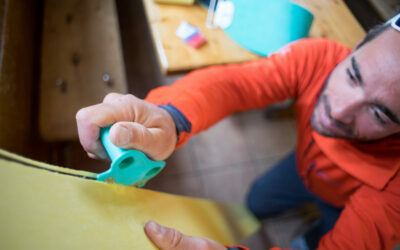
Christian Iversen Styve
Text and imagesAdventurer and polar guide extraordinaire. Christian has been expedition leader for close to 35 expeditions. Has been to the South Pole four times, has crossed Greenland several times and is an avid kiter..

Crister Næss
Additional text and editorÅsnes-branded gear genius and ski-teste, among other things.
Everything you need to get started with tyre training!
Tyre training’s a fantastic form of training. Not only for for longer tours and expeditions, but for skiing and physical fitness in general.
Below, we’ll show you how to proceed, step by step, to make your own set of tyres for training. You’ll have an excellent set-up for training in the off-season.
Equipment for tyre training doesn’t have to be expensive at all. If you already have a harness and enough rope for a tug-o’-war, then you’re already well on your way.
If you don’t have any old tyres lying around, they’re quite easy to get hold of. If you pop into a local tyre dealer or a car wrecker, they often have loads lying around. If you ask nicely, they’ll probably let you take some off their hands.
What you need to get started
Here’s a list of what you need to make a good tyre training kit. It’s not rocket science. You can most of it from the local hardware store. In Norway the usual suspects, Biltema or Clas Ohlson, should have what you need.

The benefits of tyre training
What to do – step by step
First: drill holes in the tyres to mount the eyebolts. Here we used a standard wood bit to drill the holes. Simple, straightforward and not difficult at all.
Then just push the eyebolts into the holes, put the washers in place and fasten the nut. If the washers are too small, find some with a larger diameter.


Link the tyres
If you want to pull two tyres, use a chain to link them – rope wears out pretty quickly. This way you have a tyre set that’ll last for years without the rope rotting away.





The rope
Rig the rope using climbing rope, 6mm static rope, or any other good rope you have lying around.
Tie the carabiners to the ends of the rope with a double figure-eight knot, half-knot, or double overhand knot at each end. Make sure the rope’s 2.5 to 3m from the tyre to harness.
It is a good idea to loop the rope at the towing harness (see the picture). This way, the carabiner attached to the harness has some play and you pull, correctly, from the hip.
The only thing to do know is to hit the gravel pulling your tyres!

Professor Per Morten Fredriksen of the Norwegian College of Health has studied the effects of tyre training
Several recent studies, experience from expeditions, feedback from guides and guiding organisations show that training by pulling car tyres has a great effect. Per Morten Fredriksen PhD of the Norwegian College of Health has carried out perhaps the most extensive research into this form of exercise.
The researcher compared running on a treadmill to training with car tyres. They had a test group of students run with a 5% angle at 10 kilometers per hour and compared it with walking 4 kilometers an hour with two car tyres in tow on various surfaces, mostly asphalt. Beyond the aerobic effect (that is, improvement in endurance), subjects strengthened the upper body. This doesn’t occur in comparable exercises such as running or cycling.
Another advantage is that the load is distributed and not concentrated on the legs, especially when walking uphill. It’s good for those who can’t run, perhaps for reasons of injury. While it’s not an especially punishing form of training, in terms of joints and tendons, on a steep downhill you might possibly feel it a bit in the achilles.
You certainly can feel it, however, on your muscles and cardiovascular system. So don’t take it too hard. You can over-do it. But people are different, says Per Morten Fredriksen; you have to know your own limits.
The Tyre-Pullers Code

Boots for cross-country skiing in the backcountry
Nothing ruins the skiing experience as effectively as foot-related woe. Blisters. Wet socks. Sore arches. These things are the enemy. Good ski boots are incomparable – cherish yours once you’ve found them. Here’s a guide to help you find them.

Tips for long distance ski tours
The first thing I want to say is that if you’re dreaming of something – do it. Just start making it happen! Don’t put it off. Because if there’s one thing that’s certain, it’s that you won’t regret it. It’s amazing what you can achieve if you only begin.

Replacing and renewing glue on skins
Unfortunately, skin glue doesn’t last forever. The skin itself, on the other hand, only gets better and better until it wears out. So if you replace the old glue, your skins can last many years. Moribund glue can be replaced, either with tape or sheets, or from a tube. We explain how.

Which cross-country skis? And how long?
Choosing new cross-country BC skis is can be bewildering. We compare length, width, profile. We weigh ourselves and check again. We ask advice on forums. We change our minds repeatedly. So before you pull the trigger, set your mind at rest by reading this overview. If you’re still unsure, you can talk to the expert in your local specialist shop or contact Åsnes’s customer service – we answer questions the whole time and we can usually help!

Tailoring long skins for alpine touring
Wondering how to tailor your skins for alpine touring? Here’s an overview – care and trimming long skins for touring skis.

Setting up camp – essential routines
Preparation is, as always, everything. You can never be too well practiced and prepared. Take pitching a tent in strong winds, for instance. It’s something you can train for…